Three steps closer
Editor's note: Anouk Willems is research innovation manager in the Rotterdam, Netherlands office of research firm InSites Consulting. Tom De Ruyck is head of research communities at InSites Consulting in the Ghent, Belgium office. Based in the firm’s New York office, Niels Schillewaert is managing partner and cofounder.
There will always be a gap between what a consumer is sharing and how a researcher understands it. This disparity is created by a gap in culture, generation or objective knowledge. These different gaps make it difficult for a researcher to put things in the right perspective. But consumers can help us out. By becoming our co-researchers, they complement the researcher’s tasks and help to find more and new insights that would otherwise not have been captured. Customers feel empowered and honored when they are asked to become co-researchers. There are many ways to collaborate with co-researchers throughout the research process, from moderation until reporting. In this article, our experience with co-researchers is illustrated in three case studies from Campbell’s, Air France and KLM, and Philips.
Willing to collaborate
The new buzzword in the research industry is collaboration. Today, many consumers are willing to collaborate with brands in market research online communities (MROCs) or consumer consulting boards. For collaborations to be really successful, it is key that there is an equal relationship between all parties and that they consider each other as true partners. In MROCs, we consider the participants as equal partners more than other methods. We empower them to start their own discussions and enable them to share (un)solicited feedback. However, the roles are still separate: We are the researchers, they are the participants. For successful collaboration, we need to challenge these traditional, distinct roles and examine the convergence of the roles of a researcher and participant.
What would happen if we were to bring down these walls and turn participants into researchers? Our recent case studies demonstrate that community participants are not only perfectly capable of taking on the role as co-researchers, it’s also a way to close cultural, generational and knowledge gaps. By placing participants in the role of co-researcher, we can analyze a research question from multiple perspectives to establish validity in qualitative research. This links back to the concept known as triangulation. The way we use triangulation is similar to investigator triangulation, which involves several different investigators during the research process (Guion et al, 2002). So far, triangulation hasn’t been applied to participants as co-researchers. In this article, we illustrate three ways how community members become co-researchers: by moderating, analyzing and fine-tuning conclusions (see Table 1).
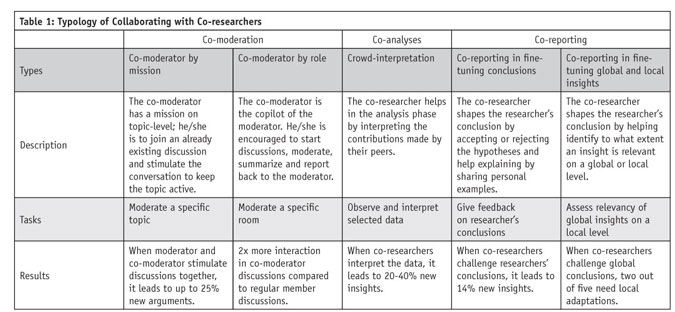
Start behaving as moderators
MROCs allow us to build an ongoing connection with our participants. After an introductory period, we have gained their trust and participants know their way around the community. Even members who were not familiar with communities before learn quickly how they work, what the role of the community manager is and what is expected of them. Without introducing the official role of a “co-moderator” we already see some members start behaving as moderators by asking questions or raising general issues. Of the 15 most recent communities we have set up, this moderator behavior is visible in the “off-topic rooms” of 12 of them. (Off-topic rooms are areas on the community where members can start their own discussions and talk about anything they want.) This moderator behavior is observed when members start new topics with question(s) about the brand/topic of the research, to trigger a new discussion and ultimately to contribute to the end goal of the research community. These are questions that are new to the research and that clients and researchers have not asked. For example, in a recent community about coffee, one member started a discussion on reasons why we drink coffee:
We have been talking about drinking coffee for a few weeks now and I think it’s not only just because it’s tasty, comforting, energizing etc. For me, I think it’s a peace of mind. I used to work on a farm. Around 10 am, everyone came to the kitchen for a break and we drank coffee together. There was then some talking and when the coffee was finished everyone went back to work. Sitting down and having a break was only done if there was coffee! So, coffee is about having a break and relaxing. Do you agree? What are your reasons for drinking coffee?
This natural moderator behavior already shows there’s potential for empowering participants to be part of the research team and become actual co-moderators. There are various ways to introduce co-moderators into the community. We have identified two types of co-moderator: by role and by mission.
Role
The co-moderator task “by role” is endorsed as another moderator in the MROC of a specific room (i.e., the social corner). The co-moderator is encouraged to start discussions by themselves, moderate, summarize and report back to the moderator. In the community “Come Dine With Me” that we ran for Campbell’s, 23 percent of the participants indicated upfront they were interested in being a co-moderator . Ultimately, the selected co-moderator took his role very seriously and started completely new topics in a dedicated room. By qualitative coding of the discussions, we concluded that the efforts of the co-moderator-by-role resulted in two times more interaction in the discussion compared to threads started by a regular (non-co-moderator) member. Furthermore, based on a qualitative interview with a co-moderator in the Come Dine With Me community, we learned that the role of a co-moderator is very rewarding:
I really enjoyed being a co-moderator, it really felt like I was playing an important role and that I was being heard. Thank you for asking me to do that, I would love to do it again.
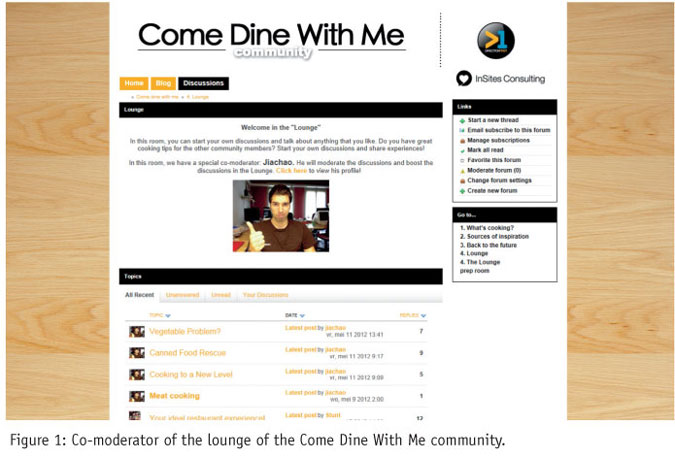
Mission
The co-moderator “by mission” tries to complete a secret assignment. Instead of being “responsible” for one room, the mission for this co-moderator is to join an existing discussion and stimulate the conversation to keep the topic active. After, as in the case of the co-moderator-by-role, they summarize the discussion and report back to the moderator. In the Campbell’s community, we did an experiment where we asked participants to join a discussion on the topic of “your ideal restaurant experience.” By qualitative coding of the discussions and comparing the arguments of the co-moderator thread with a control group, we found that 25 percent more arguments were triggered by a co-moderator-by-mission. Also for this role, the qualitative interviews with the co-moderators showed us they were positively surprised. As one commented:
I accept the challenge and look forward to reporting back to you with my findings. Should be fun!
In a new study with Campbell’s, we observed from the qualitative interviews that working with co-moderators increases the general engagement of all the members. The conversation can be even more open as it is peer-to-peer, with everyone speaking the same language. Also the findings are summarized from a consumer point of view, not that of a researcher, thus bringing another mind and a different perspective to the analysis process. Using co-moderators also reaffirms to all participants that the MROC is about listening, sharing and collaborating (Luke et al., 2012).
Working with a co-moderator-by-mission helps to keep the discussion relevant and dynamic. Plus, the questions are posed from a peer’s point of view, which helps to close the participant-researcher gap. The difference between both types is that co-moderators-by-mission stimulate discussions on the topic level while co-moderators-by-role go one step further and take over a whole forum. They collaborate with the members on a structural level, resulting in closer P2P relations and increasing the social glue of the community. Overall, based on the qualitative interviews with the participants, co-moderatorship is perceived to be very rewarding for both the co-moderator and other participants, as illustrated by this comment from a Come Dine With Me, Australia participant:
How interesting that you used a couple of the other members to help you and ask us questions too. It’s a great idea, they know where we are coming from and they understand what we are talking about so it’s easier to talk to them.
Multiple perspectives
Next to moderating, participants can also add value when they are involved during the analysis phase, also referred to “crowd-interpretation.” The rationale behind crowd-interpretation is that analysis of data is biased by a researcher’s gaze. To get all potential interpretations and insights hidden in the data, we need to include multiple perspectives.
Recently, we conducted an insight community in cooperation with Air France and KLM where we wanted to detect new needs of transfer passengers. After an observational stage where each transfer passenger reported their journey, we invited the community members to interpret each other’s contributions. From previous research (Verhaeghe et al., 2011), we know that consumers that are knowledgeable about the topic are most suitable for interpreting research results.
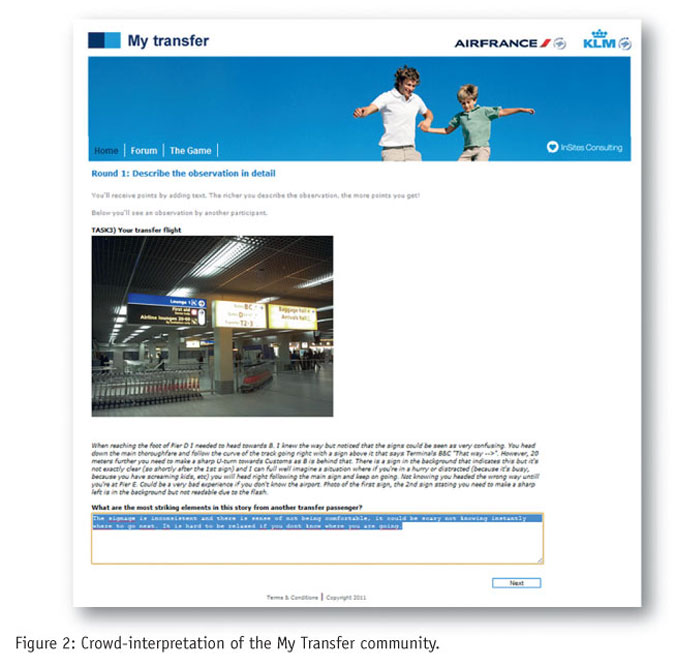
The crowd-interpretation was done in a game. During the first round, members had to give their interpretation on the input of their peers. In the second round, the original contributor could rate the analysis. Upon each correct analysis, a member could receive points. Consumers who were best in the analysis (highest amount of points) won the game and got a special incentive. Comparing the results of the researcher group with those of the participants, we concluded that involving co-researchers led to up to 21 percent more new insights (Verhaeghe, et al., 2012; Verhaeghe, et al., 2011). Next to overcoming a knowledge barrier, the same technique can also close potential contextual blind spots. For example, we also conducted crowd interpretation for a Gen Y community in cooperation with MTV. The researchers involved in this Gen Y community were not all from Gen Y. Using crowd-interpretation with like-minded peers of the participants generating the data helped us to overcome this generation gap. Thus, involving community participants in the analysis phase brings new insights to the table and helps researchers to close the gaps.
Fine-tune conclusions
Another way to involve participants in research tasks is by asking them to fine-tune conclusions, almost like a dry run for the community participants instead of the company. This technique was used in a study we conducted last year for Philips for which we set up a three-week insight-shaping community with 50 Chinese consumers.
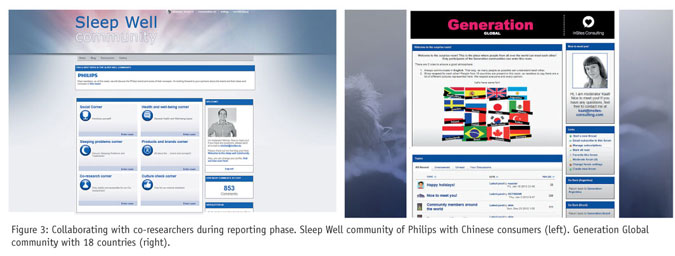
In ideal circumstances, native moderators are used. But due to time and budget constraints, as well as the fact that Philips executives wanted to join the conversation, we had to work with a non-native-English-speaking moderator. The community was run in English and while participants took a language test, the fear existed we would lose out on the nuances of Chinese culture and society. To avoid this and to increase positive feedback loops for enriched information-generation we used 10 of our participants as our co-researchers to deepen our insight-mining.
After we completed our analysis of the community output, we presented our findings to these participants and asked them to challenge them. For this co-analysis, they were asked to explain our initial conclusions from the Chinese cultural perspective, illustrate our findings with their own personal examples and elaborate on our first impressions. By means of qualitative coding of co-researcher discussions, we found that in 14 percent of the co-researchers’ posts, the conclusions were challenged (nuanced or rejected). This means that every one out of seven posts includes new information that helps to fine-tune our conclusions. For example, the meaning and importance of well-being was challenged by our co-researchers. Where our conclusion initially was that Chinese consumers value well-being, the co-researchers explained that it’s more about being healthy in order to work hard, earn more money and ultimately improve life status.
Working with co-researchers this way created truly unique insights that were key for Philips to find the right positioning in the Chinese market. We, as researchers and marketers, would never have uncovered these insights from an online distance (Schillewaert et al., 2012).
Validate and improve
The case of Philips shows how co-researchers can help us to validate and improve our hypotheses. Next to helping us understand a different culture, co-researchers can also help us to go across cultures and capture the global overview in a multicountry study.
We recently ran an MROC study in 18 different countries for three weeks for a multinational FMCG company. Each country had its own community platform and local native moderators, allowing all participants to express themselves in their local language. After three weeks, we opened up an extra discussion room and invited all members who could express themselves in English to become co-researchers and challenge the conclusions on themes that were thought to unite all countries. Five cross-country findings were launched in the global room. Three of these statements were confirmed on a global level whereas the other two were disputed and therefore need to be adapted on a local level. This example showed us how co-researchers can help us find and develop a global overview faster and better.
Close gaps
Through these three case studies, we have experienced the added value of co-researchers in communities and learned how and when to use them. In the previous studies, we collaborated with co-researchers who were like-minded peers of the participant group. But there are more opportunities here. For instance, we are now collaborating with expert groups such as health care practitioners to help interpret the contributions of patients. This way, we believe we can get more out of the data by involving all stakeholders to the research.
Furthermore, there are also new opportunities to collaborate with co-researchers in the analysis phase to better understand how opinions are shared and to uncover the metaphors and word meanings of discussions.
Working with co-researchers is not for everybody. It’s an extra challenge that participants need to be interested in, invest time in and perceive as an exclusive reward. It is not necessarily a bad thing that not all participants want to become a co-researcher; we believe that there’s a saturation effect in terms of co-researchers' additional findings and arguments. So, finding that optimal number of co-researchers is an important direction for us in future research.
Besides this, there are many opportunities for engaging co-researchers (Figure 4). We are currently experimenting with co-researchers as trend-watchers, where we ask them to become our eyes and ears in the offline world and report back to us on the community. This form of co-researching gives the participants even more responsibility, status and thus a higher perceived feeling of exclusiveness. Furthermore, another direction of future research is to discover the types of participants that consider being a co-researcher a real challenge. In order to motivate them in the best way, we need to know who to approach and how to challenge them.
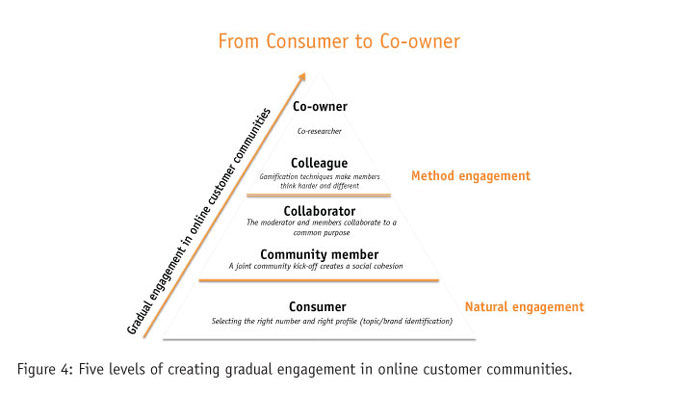
Co-researchers are the future of our profession. Participants have become our partners with whom we collaborate. When we put community participants into a different context such as a co-researcher, it does not replace the researcher. This is similar to what we see in co-creation activities in innovation and marketing disciplines, where the job of the marketer isn’t made obsolete. Rather, it’s about collaboration and sharing the responsibility of the research community in order to come up with results and findings we would otherwise have missed. Co-researchers are not a threat but a real opportunity, one that we believe is the way forward for our profession as market researchers.
References
De Ruyck, T. and Veris, E., 2011. "Play, interpret together, play again and create a win-win-win." InSites Consulting white paper, www.insites-consulting.com/play-interpret-together-play-again-and-create-a-win-win-win/.
Guion, L.A., Diehl, D.C., and McDonald, D., 2002. "Triangulation: Establishing the validity of qualitative studies." FCS6014, University of Florida.
Luke, M., Grant, R., Cappuccio, R., De Ruyck, T. and Willems, A., 2012. "Come Dine With Me, Australia." Proceedings for AMSRS Conference 2012.
Schillewaert, N., De Ruyck, T., Troch, T. and Wijngaarden, J. van, 2012. "When information is hard to get: Creating positive feedback loops through engagement in online research communities." http://tinyurl.com/b5bwtxf.
Verhaeghe, A., Hageman, C., Troch, T. and De Ruyck, T., 2012. "Doing more with less." Proceedings for ESOMAR Qualitative 2012.
Verhaeghe, A., Schillewaert, N., Van den Bergh, J., Ilustre, G. and Claes, P., 2011. "Crowd interpretation. Are participants the researchers of the future?" Proceedings for ESOMAR Congress 2011.
